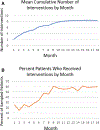Effects of a refined evidence-based toolkit and mentored implementation on medication reconciliation at 18 hospitals: results of the MARQUIS2 study
- PMID: 33927025
- PMCID: PMC10964422
- DOI: 10.1136/bmjqs-2020-012709
Effects of a refined evidence-based toolkit and mentored implementation on medication reconciliation at 18 hospitals: results of the MARQUIS2 study
Abstract
Background: The first Multicenter Medication Reconciliation Quality Improvement (QI) Study (MARQUIS1) demonstrated that mentored implementation of a medication reconciliation best practices toolkit decreased total unintentional medication discrepancies in five hospitals, but results varied by site. The objective of this study was to determine the effects of a refined toolkit on a larger group of hospitals.
Methods: We conducted a pragmatic quality improvement study (MARQUIS2) at 18 North American hospitals or hospital systems from 2016 to 2018. Incorporating lessons learnt from MARQUIS1, we implemented a refined toolkit, offering 17 system-level and 6 patient-level interventions. One of eight physician mentors coached each site via monthly calls and performed one to two site visits. The primary outcome was number of unintentional medication discrepancies in admission or discharge orders per patient. Time series analysis used multivariable Poisson regression.
Results: A total of 4947 patients were sampled, including 1229 patients preimplementation and 3718 patients postimplementation. Both the number of system-level interventions adopted per site and the proportion of patients receiving patient-level interventions increased over time. During the intervention, patients experienced a steady decline in their medication discrepancy rate from 2.85 discrepancies per patient to 0.98 discrepancies per patient. An interrupted time series analysis of the 17 sites with sufficient data for analysis showed the intervention was associated with a 5% relative decrease in discrepancies per month over baseline temporal trends (adjusted incidence rate ratio: 0.95, 95% CI 0.93 to 0.97, p<0.001). Receipt of patient-level interventions was associated with decreased discrepancy rates, and these associations increased over time as sites adopted more system-level interventions.
Conclusion: A multicentre medication reconciliation QI initiative using mentored implementation of a refined best practices toolkit, including patient-level and system-level interventions, was associated with a substantial decrease in unintentional medication discrepancies over time. Future efforts should focus on sustainability and spread.
Keywords: healthcare quality improvement; medication reconciliation; patient safety; pharmacists; transitions in care.
© Author(s) (or their employer(s)) 2022. No commercial re-use. See rights and permissions. Published by BMJ.
Conflict of interest statement
Competing interests: JLS has received funding from Mallinckrodt Pharmaceuticals for an investigated-initiated study of opioid-related adverse drug events. JLS and AM received remuneration from American Society of Health-System Pharmacists (ASHP) to develop their best possible medication history training curriculum.
Figures


References
-
- Coleman EA, Berenson RA. Lost in transition: challenges and opportunities for improving the quality of transitional care. Ann Intern Med 2004;141:533–6. - PubMed
-
- Forster AJ, Murff HJ, Peterson JF, et al. The incidence and severity of adverse events affecting patients after discharge from the hospital. Ann Intern Med 2003;138:161–7. - PubMed
-
- Kripalani S, LeFevre F, Phillips CO, et al. Deficits in communication and information transfer between hospital-based and primary care physicians: implications for patient safety and continuity of care. JAMA 2007;297:831–41. - PubMed
-
- Moore C, McGinn T, Halm E. Tying up loose ends: discharging patients with unresolved medical issues. Arch Intern Med 2007;167:1305–11. - PubMed
Publication types
MeSH terms
Grants and funding
LinkOut - more resources
Full Text Sources
Other Literature Sources
